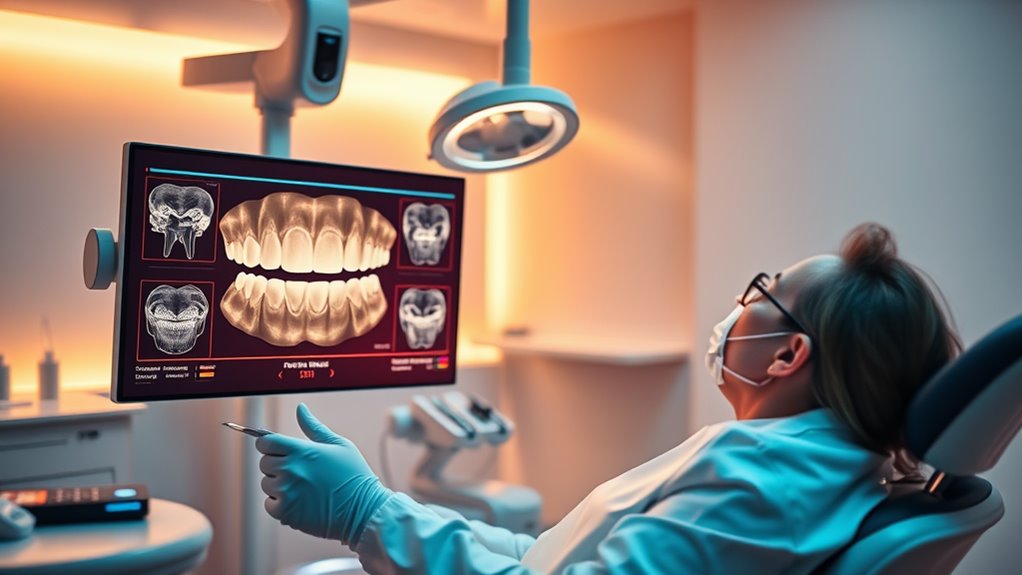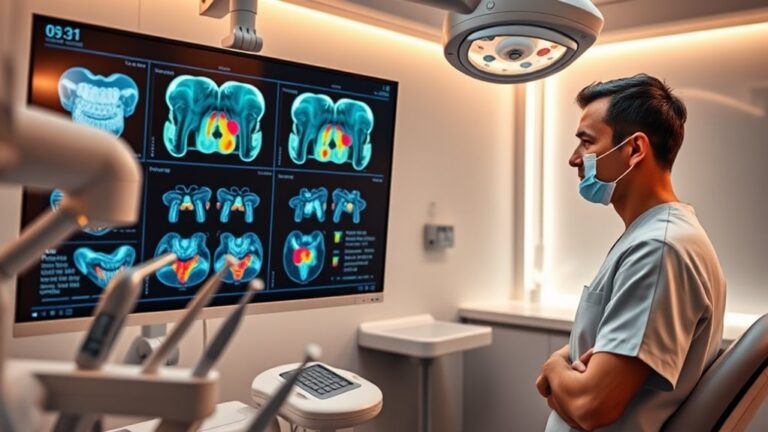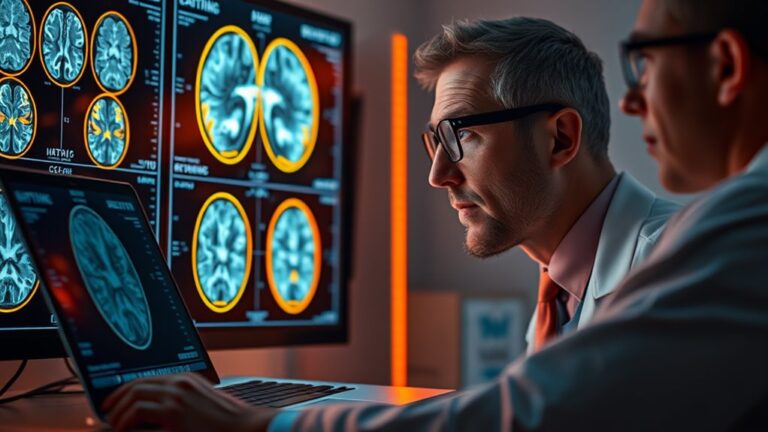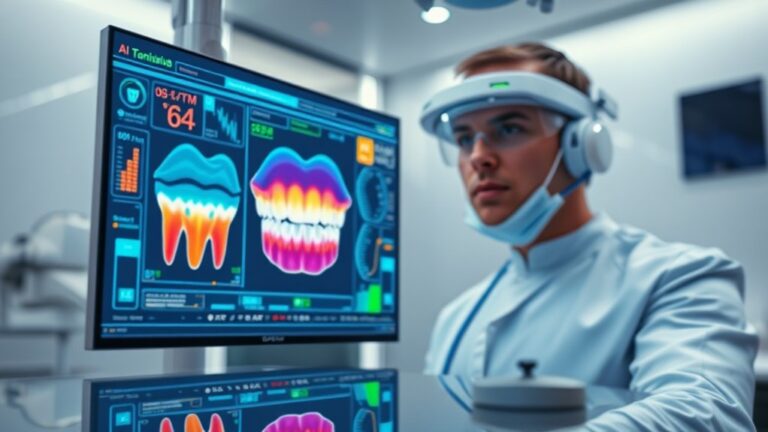Deep Learning: Transforming Diagnostic Insights in Dentistry
You might not realize that deep learning can analyze dental images with accuracy levels surpassing 98%, far exceeding traditional methods. This cutting-edge technology is reshaping how dental professionals diagnose and treat various conditions, but its implications go beyond mere numbers. As you consider the potential benefits and challenges of integrating these advanced systems into everyday practice, you'll find that the intersection of AI and dentistry holds significant promise for the future of patient care. What does this mean for both practitioners and patients alike? If you have questions or need assistance navigating this topic, feel free to reach out to us. We can connect you with experts who can provide tailored solutions to enhance your understanding and implementation of these innovative technologies.
Overview of Deep Learning in Dentistry
Deep learning is revolutionizing the field of dentistry by enhancing diagnostic accuracy and streamlining clinical workflows.
Recent systematic reviews have compiled extensive research, analyzing over 101 studies from reputable databases like PubMed and Scopus. These studies highlight the significance of deep learning architectures, particularly Convolutional Neural Networks (CNNs), which include models like VGGNet19 and ResNet50, achieving classification accuracies exceeding 99.90%.
As you navigate this landscape, you'll notice a growing emphasis on explainable models that foster human-AI collaboration. These explainable models not only provide high diagnostic performance but also enhance trust among practitioners, allowing you to make informed decisions based on AI insights. In fact, studies have shown that deep learning models can detect dental diseases with high accuracy, including dental caries and periodontal disease.
While statistical tests demonstrate superior AI performance compared to human counterparts, the integration of human expertise remains vital.
With the increasing number of publications and training datasets, the path forward involves addressing challenges like data standardization and the need for publicly available dental datasets. By focusing on explainable AI methods and collaborative approaches, you're equipped to leverage deep learning effectively, ultimately improving patient outcomes in dental practice.
Key Applications in Dental Imaging
Advancements in dental imaging are substantially reshaping diagnostic practices, with deep learning technologies playing a pivotal role. These innovative applications enhance image quality and promote data standardization, ensuring consistency in diagnostics.
Dental Caries Detection
Deep learning models achieve diagnostic accuracies of 89% for premolars, utilizing CNN algorithms like GoogLeNet Inception v3.
Tooth Identification and Numbering
With accuracy rates ranging from 81.8% to 99%, object detection models like YOLO efficiently identify teeth in panoramic radiographs.
Periodontal Disease Assessment
Algorithms analyze panoramic images to determine disease stages, boasting a high correlation index, which aids in treatment planning.
Oral and Maxillofacial Surgery
CNNs like VGG-16 identify lesions with an accuracy of 83%, facilitating surgical decisions.
These applications not only improve diagnostic precision but also empower clinicians to deliver better patient care.
Advantages Over Traditional Diagnostics
In the domain of dental diagnostics, the advantages of deep learning technologies over traditional methods are strikingly evident. With AI adoption, you can expect enhanced accuracy in identifying subtle patterns that human practitioners might overlook. For instance, deep learning can achieve up to 14% higher accuracy in diagnosing periodontal disease, substantially reducing instances of misdiagnosis.
This technology processes data consistently, outperforming traditional architectures like VGG and EfficientNet. Furthermore, deep learning models can be trained on large datasets, which improves diagnostic accuracy over time.
Moreover, deep learning streamlines the diagnostic process, reducing diagnostic time by 35%. This efficiency allows you to focus on more complex cases and improve patient interactions, ultimately enhancing their experience. By automating routine tasks, you can also minimize waiting times, ensuring timely care for your patients.
Deep learning facilitates early detection of dental issues, helping you identify potential problems at their earliest stages. This proactive approach leads to less invasive treatments and better outcomes. Additionally, it standardizes diagnostic processes across practices, ensuring regulatory compliance and uniform quality of care.
As deep learning continuously learns from new data, it improves diagnostic capabilities over time, allowing for personalized preventive care strategies that enhance patient outcomes across diverse populations.
Deep Learning Architectures Used
When exploring the domain of dental diagnostics, you'll find that several deep learning architectures have revolutionized the way you approach image analysis. These architectures leverage advanced techniques like attention mechanisms and model customization to enhance diagnostic accuracy and efficiency.
Convolutional Neural Networks (CNNs)
These are the backbone of many dental image tasks, excelling in detection and classification.
Pre-trained CNNs
Models such as VGG-16 and ResNet-101 provide a strong foundation for various diagnostic applications, reducing the need for extensive training data.
Faster R-CNN and YOLO
These architectures are tailored for object detection, allowing you to identify anatomical structures and pathologies effectively. Dental informatics integrates these technologies to improve patient outcomes and streamline clinical workflows.
U-Net
This model specializes in segmentation tasks, vital for delineating teeth and jaw bones in radiographic images.
Training and Evaluation Processes
Training and evaluation processes play a pivotal role in harnessing the power of deep learning for dental diagnostics. To effectively train models, you'll need a robust dataset consisting of diverse dental images, including intraoral photographs and X-rays.
Data augmentation techniques enhance this dataset, creating variations that improve model robustness and generalizability. By optimizing models, you guarantee they can learn effectively from the data, using architectures like Convolutional Neural Networks (CNNs).
During the training phase, split your data into training and validation sets to monitor performance and prevent overfitting. Utilize optimization algorithms to adjust model weights, aiming for metrics like the F1 score and mean average precision.
Once trained, evaluate your model's efficacy using performance metrics such as the correlation index and intraclass correlation index, comparing results against traditional methods to highlight improvements.
Real-world validation is essential; testing your model on actual dental images guarantees it's ready for clinical use. Regular feedback and continuous improvement are important to adapt to new data and evolving diagnostic needs.
This meticulous approach to training and evaluation ultimately enhances diagnostic accuracy, benefiting both practitioners and patients.
Challenges in Implementation
Implementing deep learning in dentistry presents a range of challenges that can hinder progress and efficacy. You'll need to navigate several key hurdles to guarantee successful integration:
- Data Scarcity: High-quality, large datasets are essential, yet often unavailable, limiting the training of effective models. This issue is compounded by the limited availability of datasets that affects AI model performance.
- Annotation Challenges: Creating annotated datasets demands significant time and expertise, and inaccuracies can lead to unreliable outcomes.
- Computational Costs: The high computational demands necessitate efficient models, requiring investment in advanced technologies and resources.
- Technological Adaptation: Dental professionals must adapt to these new technologies, which can be a barrier to widespread adoption.
Moreover, regulatory compliance is critical due to the sensitive nature of patient data. Adhering to data protection regulations, like GDPR, complicates data management and increases the need for robust security measures.
As you work to implement deep learning, consider these challenges carefully. Addressing them is essential to fostering trust among dental professionals and patients alike while guaranteeing that the innovations enhance diagnostic capabilities in a responsible and ethical manner.
Future Directions for Research
Future research in deep learning for dentistry is poised to revolutionize diagnostic and treatment methodologies, addressing both current limitations and emerging opportunities. By integrating advanced imaging techniques like mixed reality (MR) and augmented reality (AR), you can enhance diagnostic accuracy and clinical training. Developing deep learning models that analyze 3D data will improve image recognition for various dental anomalies, supporting more effective treatment planning.
The focus on personalized treatment planning will allow you to harness AI-driven recommendations tailored to individual patient needs. This won't only lead to better outcomes but also empower you to make informed decisions in clinical cases. With the expanding applications of deep learning across dental disciplines—from operative dentistry to orthodontics—you can anticipate significant advancements in detection and treatment planning. Additionally, the integration of deep learning into dental practices can streamline the analysis of vast amounts of patient data, enabling more precise diagnostics.
Moreover, addressing methodological limitations through systematic reviews and the use of larger, more diverse datasets will enhance the external validity of your findings. As tele healthcare continues to grow, combining it with augmented intelligence in dentistry will elevate the standard of care. Embracing these future directions will ultimately serve patients better, ensuring that they receive the most accurate and personalized care possible.
Impact on Patient Care
Transforming patient care, deep learning technologies are ushering in a new era of precision and personalization in dentistry. You'll find that these advancements enhance the overall patient experience in significant ways:
- Enhanced Diagnostic Accuracy: AI systems identify dental issues with remarkable precision, enabling early intervention and improved treatment outcomes, which builds patient trust.
- Personalized Treatment Planning: By simulating various treatment outcomes, AI allows you to visualize results and set realistic expectations, fostering treatment adherence. The use of AI algorithms enhances the capabilities of treatment simulations, leading to better-informed decisions.
- Improved Patient Engagement and Education: AI's visualization capabilities demystify complex procedures, making it easier for you to understand your oral health and actively participate in your treatment journey.
- Streamlined Clinical Workflow: By automating routine tasks, AI frees up dental professionals to focus on personalized care, enhancing the efficiency of your visits.
Integrating deep learning technologies not only elevates the standard of care but also nurtures a collaborative relationship between you and your dental provider.
As you engage with these innovations, you'll likely experience greater satisfaction, adherence to treatment plans, and an overall improvement in oral health.
Ethical Considerations in AI Use
As dental practices increasingly adopt AI technologies, numerous ethical considerations arise that demand careful attention. One vital aspect is data ownership. You need to guarantee that patient information is handled securely and ethically. Transparency about how you use this data is essential, as patients deserve to know how their sensitive information is treated. Robust data protection measures must be implemented to prevent breaches, along with strict compliance with privacy laws.
Algorithmic fairness is another significant concern. AI systems are only as effective as the data they're trained on; biased datasets can lead to unfair treatment outcomes. To provide equitable care, it's vital to train AI systems on diverse datasets and continuously monitor and adjust algorithms to mitigate bias. Transparency in the origins and labeling of the data helps address these issues, fostering trust in AI tools. Moreover, the effectiveness of AI in improving diagnostic accuracy depends on its ability to analyze radiograph analysis effectively.
Lastly, establishing clear accountability guidelines is necessary. When errors occur, it's crucial to determine whether responsibility lies with you, the AI developers, or the system itself.
Frequently Asked Questions
How Do Deep Learning Models Improve Dental Disease Detection Accuracy?
Deep learning models enhance dental disease detection accuracy by employing advanced feature extraction techniques and pattern recognition algorithms. This combination allows you to identify subtle anomalies, ensuring more reliable diagnoses and improved patient outcomes in dental practices.
What Types of Imaging Data Are Used in Dental Deep Learning?
In dental deep learning, you utilize various imaging modalities like panoramic and periapical radiographs. Data augmentation enhances image variability, improving model robustness and accuracy in detecting and diagnosing dental conditions effectively for better patient care.
Can Deep Learning Models Adapt to New Dental Diseases Over Time?
Yes, deep learning models can adapt to new dental diseases over time through model updates and disease generalization techniques. By continuously retraining on diverse datasets, you enhance their accuracy and applicability in clinical settings.
How Do Dental Professionals Interact With Deep Learning Systems?
Traversing the digital landscape, you engage with deep learning systems through clinical integration and user training. These tools enhance your diagnostic capabilities, streamline workflows, and empower you to provide superior care for your patients.
What Is the Expected Timeline for Widespread Adoption of These Technologies?
You can expect widespread adoption of AI technologies in dentistry within the next five to ten years, contingent on addressing ethical considerations and establishing robust regulatory frameworks that guarantee safety, effectiveness, and trust in these innovations.
Conclusion
In summary, deep learning is reshaping dental diagnostics like a magic wand, transforming how you detect and treat dental issues. Its unparalleled accuracy and efficiency not only enhance patient care but also streamline your workflow. As you embrace these innovative technologies, you'll witness a revolution in personalized treatments and early detection, ultimately leading to better outcomes for your patients.
If you're looking to navigate this exciting landscape and implement deep learning solutions in your practice, we encourage you to reach out to us for expert assistance. By seeking our help, you can save time, reduce stress, and significantly improve your dental practice. The future of dentistry is bright, and with deep learning at the forefront, we are here to support you in redefining the standards of care for your patients.





